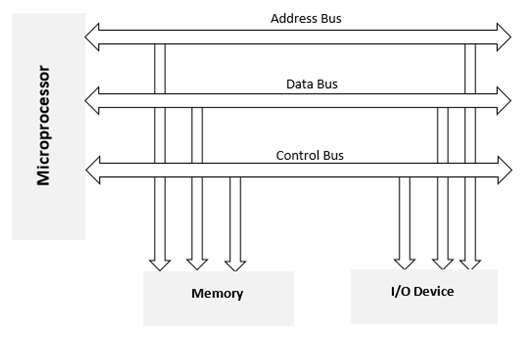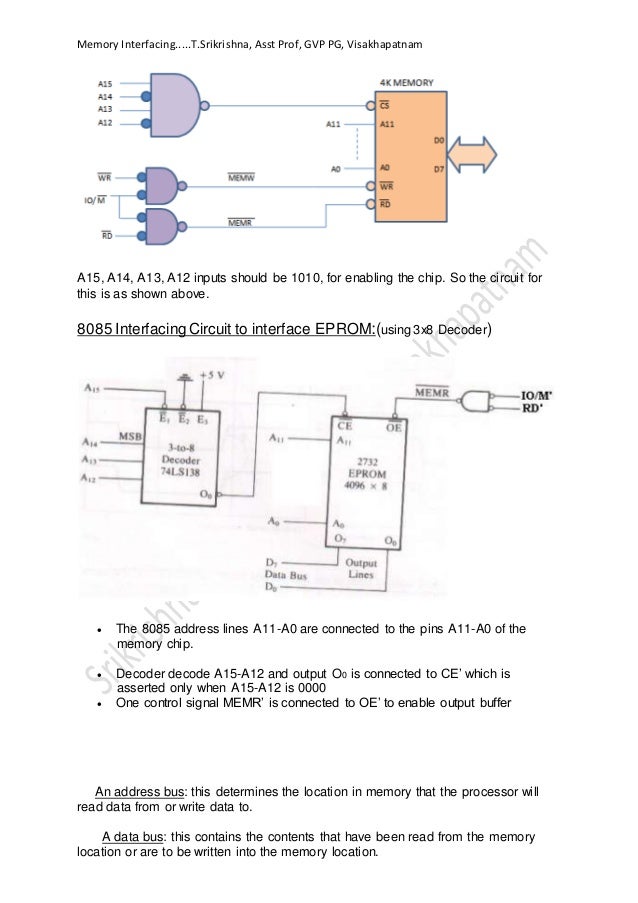Memory Interfacing In 8085 Microprocessor Pdf
Posted By admin On 07/05/19May 23, 2010 - 8085 Microprocessor: Architecture & Support Components; 2. 8085 Interfacing with Memory chips 8085 Memory Interface Memory Chip. Feb 13, 2018 - Memory Interfacing In 8085 Microprocessor Pdf. Microprocessor Systems. Memory Types. Interfacing 8-bit memory/IO (8088). Interfacing 16-bit.
Presentation on theme: 'Index What is an Interface Pins of 8085 used in Interfacing Memory – Microprocessor Interface I/O – Microprocessor Interface Basic RAM Cells Stack Memory.'— Presentation transcript:
I/O INTERFACING. It is a specially designed microprocessor having a local memory of its own. Microprocessors 14 8085 is pronounced as 'eighty-eighty-five.
1 Index What is an Interface Pins of 8085 used in Interfacing Memory – Microprocessor Interface I/O – Microprocessor Interface Basic RAM Cells Stack Memory. 1
2 8085 Interfacing Pins 8085 Higher Address Bus Lower Address/Data Bus ALE READY A 15 – A 8 AD 7 – AD 0 2
Microprocessor Interfacing 8086
3 Address Bus of 8085 Address Bus – Used to address memory & I/O devices – 8085 has a 16-bit address bus A 15 A 14 A 13 A 12 A 11 A 10 A9A9 A8A8 AD 7 AD 6 AD 5 AD 4 AD 3 AD 2 AD 1 AD 0 Lower-order AddressHigher-order Address Data Bus Used to transfer instructions and data 8085 has a 8-bit data bus Data Bus 3


4 Memory Interface The memory is made up of semiconductor material used to store the programs and data. The types of memory is, – Primary or main memory – Secondary memory 4

5 Primary Memory RAM and ROM are examples of this type of memory. Microprocessor uses it in storing a program temporarily (commonly called loading) and executing a program. Hence the speed of this type of memory should be fast. 5
6 Secondary Memory These are used for bulk storage of data and information. The main examples include Floppy, Hard Disk, CD-ROM, Magnetic Tape etc. Slower and Sequential Access Nature. non-volatile nature. 6
7 Memory Mapped IO It considers them like any other memory location. – They are assigned a 16-bit address within the address range of the 8085. – The exchange of data with these devices follows the transfer of data with memory. The user uses the same instructions used for memory. 7
8 IO Mapped IO It treats them separately from memory. – I/O devices are assigned a “port number” within the 8-bit address range of 00H to FFH. – The user in this case would access these devices using the IN and OUT instructions only. 8
9 IO mapped IO V/s Memory Mapped IO Memory Mapped IO IO is treated as memory. 16-bit addressing. More Decoder Hardware. Can address 2 16 =64k locations. Less memory is available. IO Mapped IO IO is treated IO. 8- bit addressing. Less Decoder Hardware. Can address 2 8 =256 locations. Whole memory address space is available. 9
10 IO mapped IO V/s Memory Mapped IO Memory Mapped IO Memory Instructions are used. Memory control signals are used. Arithmetic and logic operations can be performed on data. Data transfer b/w register and IO. IO Mapped IO Special Instructions are used like IN, OUT. Special control signals are used. Arithmetic and logic operations can not be performed on data. Data transfer b/w accumulator and IO. 10
11 Basic RAM Cell RAM is a type of computer memory that can be accessed randomly i.e. any location can be accessed any time within chip. It is most common type of memory found in computers, printers etc. It is basically of two types: – SRAM – DRAM 11
12 SRAM SRAM stands for Static Random Access Memory. This memory is made up of flip-flops and stores the bit as a voltage. Each cell requires 6 transistors hence chip has low density but high speed. More expensive and consumes more power. Often known as cache memory in high speed PCs. 12
13 Basic SRAM Cell 13
14 DRAM DRAM stands for Dynamic Random Access Memory. This memory is made up of MOS transistor gates and it stores the bit as charge. High density, low power consumption, cheap as compared to SRAM. Due to leakage of charge requires frequent refreshing and hence extra circuitry. 14
15 Basic DRAM 15
16 ROM ROM is a read only memory. It retains the information even if power is turned off. It contains permanently stored instructions that help in staring up of a computer e.g. BIOS or Basic Input Output System. These are of following three basic types – PROM, EPROM, EEPROM 16
17 PROM The Programmable Read Only Memory can be programmed only once in its lifetime. Information once stored can not be erased. Requires special hardware circuit to program it. 17
18 EPROM Stands for Erasable Programmable Read Only Memory. These ROMs can be erased and programmed again and again. Can be erased with UV light or electricity. Main disadvantage is that it takes 15 to 20 minutes to erase it. 18
19 EEPROM Stands for Electrically Erasable Programmable Read Only Memory. Information can be erased electrically at register level rather than erasing entire information. It requires lesser erasing time. 19
Mp3 jam free download. Each demo video focuses on particular skills or techniques in the song for a particular instrument.
20 Stack It is a part of memory, reserved in RAM, used to temporarily store information during execution of program. Starting address of stack is loaded in “Stack Pointer (SP)” (a 16-bit register). The address pointed to by SP is known as “Top of Stack”, which is always an empty memory location. 20
21 Stack Initialization Stack can be defined anywhere in RAM. But generally it initialized from highest (end) address of RAM to avoid any data loss. FFFFH F000H 0000H STACK MEMORY SP = FFFFH TOP OF STACK 21
22 Size of Stack Memory Theoretically there is no limitation on the size of stack memory. Practically the size of stack memory is limited to the availability of free RAM. As RAM is used to store temporarily program and data during execution, hence only free RAM can be used as stack. 22
23 Storing Data on Stack Stack is Last-In-First-Out (LIFO) type of memory. When information is stored on stack, the Stack Pointer register decrements to point to lower empty address. When information is read from stack, the Stack Pointer register increments to point to higher empty address. 23
24 Animation Stack Memory FFFF FFFE FFFD FFFC FFFB FFFA FFF9 0001 0000 STACK MEMORY PUSH B Stack Pointer PUSH C POP B POP C 52 H B= 52 H FFFF HFFFE H 35 H C = 35 H FFFD H 35 H 52 H 24
25 Advantages of Stack Address is always in Stack Pointer, need not be part of instruction, therefore, stack access is always faster. Stack instructions are short with only one operand. Used to save important data before branch instruction e.g. jump or interrupt instruction. 25
You can follow me at Unacademy unacademy.com/user/pawanchandani1990
To watch all Electrical Eng. Subject in a descriptive manner with previous year GATE questions
Memory Interfacing
1.Interfacing Circuits & I/O ports
2.Important Pins of a Memory Chips
3.Notation/ Representation of Memory Chips
Types of Problem on Memory Interfacing
---Finding the length of address and data bus
---Calculating No. of Chips required to design a memory
No sir you don't talk in english, aap jeyse bolte hey waise boliye plz
At 4:28 sir there are not four locations in one register each register it self one location
Nice video. But, too much of ads. Please remove half of them.
Sir can you tell me the date when 8086 microprocessor will be upload on your chanel
sir if there are 10 registers then how 1 kb memory is formed..because 10*8=80 bits hi hua.please tell me sir
It doesn't mean there are 10 registers it says if there are 10 address lines as 2^10 mean 1024 locations and each location can store 8 bit of data and hence 1024 ├Ч 8
sir iam very much confuse with this topic iam not a student but a electronics technician i need understand eprom ram eeprom nand and emmc which is using in lcd tv main board
sir the vedios of measurment are very good , and sir i am waiting of next vedio of measurment so please sir upload as soon as possible thanku sir ....
To watch complete videos of Electrical Measurements..
Go to https://unacademy.com/user/pawanchandani1990